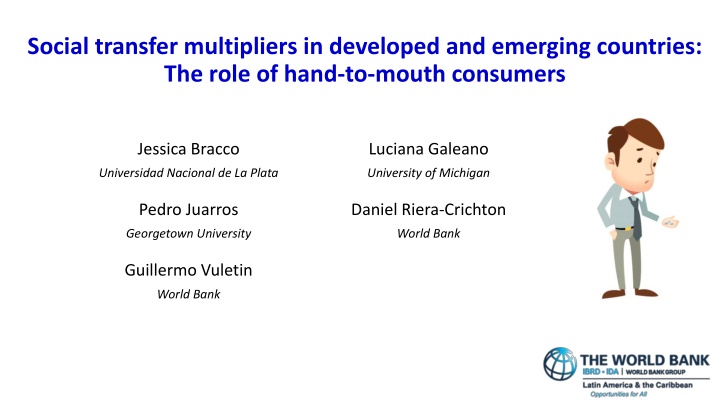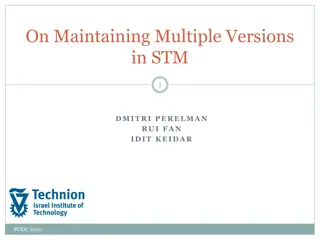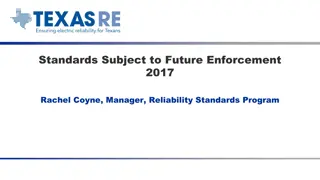
Social Transfer Multipliers in Countries: Insights and Implications
Delve into the dynamics of social transfer multipliers in both developed and emerging countries, exploring the impact of hand-to-mouth consumers and the role of social transfers in driving GDP changes. Discover empirical findings, theoretical models, and quantitative results shaping the discourse on spending multipliers and their macroeconomic implications.
Download Presentation

Please find below an Image/Link to download the presentation.
The content on the website is provided AS IS for your information and personal use only. It may not be sold, licensed, or shared on other websites without obtaining consent from the author. If you encounter any issues during the download, it is possible that the publisher has removed the file from their server.
You are allowed to download the files provided on this website for personal or commercial use, subject to the condition that they are used lawfully. All files are the property of their respective owners.
The content on the website is provided AS IS for your information and personal use only. It may not be sold, licensed, or shared on other websites without obtaining consent from the author.
E N D
Presentation Transcript
Social transfer multipliers in developed and emerging countries: The role of hand-to-mouth consumers Jessica Bracco Luciana Galeano Universidad Nacional de La Plata University of Michigan Pedro Juarros Daniel Riera-Crichton Georgetown University World Bank Guillermo Vuletin World Bank
Road map 1. Motivation and sneak peek of our findings 2. Empirics 3. Theoretical model 4. and in data 5. Quantitative results 6. Final thoughts
Road map 1. Motivation and sneak peek of our findings 2. Empirics 3. Theoretical model 4. and in data 5. Quantitative results 6. Final thoughts
Motivation During the last decade, there has been a growing literature on spending multipliers (with a special focus on total aggregate spending or government consumption). Based on well-known macro theories, the size of the spending multiplier is larger: - in recessions (Auerbach and Gorodnichenko 2010 and 2012, Riera-Crichton et al. 2015) - when the exchange rate is fixed (Ilzetzki et al. 2013) - when debt is low (Ilzetzki et al. 2013, Huidrom et al. 2019) - when monetary policy is accommodative (Christiano et al. 2011, Pennings and Giambattista 2017) - when economies are less open to trade (Gonzalez-Garcia et al. 2013, Ilzetzki et al. 2013) - when spending is financed with foreign debt (Broner et al. 2018)
Motivation Increasing attention to the macroeconomic impact of social transfers which: - mainly include unemployment benefits, family programs, and pensions - account for about 50 percent of primary spending and growing Social transfer multiplier (STM) is defined as the effect that a $1 change in social transfers has on the level of GDP What do we know about the STM? Empirical front: - Not much. Few studies for developed countries, no evidence for emerging markets (Romer and Romer 2016, Alesina et al. 2017, P rraga 2018, Gechert et al. 2020) - Empirical studies vary across several critical dimensions. STMs range between 0 and 1 - Consensus that the effect occurs through consumption rather than via investment
Motivation Theoretical front - Rely on different variants of closed-economy two-agent New Keynesian (TANK) model (Monacelli and Perotti 2011, Coenen et al. 2012, Giambattista and Pennings 2017) - Essence: - Two agents: (1- ) Ricardian and hand-to-mouth (HtM) - Gov. is able to tax Ricardian agents and transfer share to HtM agents Existing papers focus on the role of persistence and accommodative monetary policy No study has focused on how the size of the STM is affected by the heterogeneity in: - the share of HtM agents ( ) - the share of social transfers reaching HtM agents ( ) - Few related papers: - Quantitative papers for the U.S. discipline =1/3 based on Kaplan et al. (2014) - Perfect social transfers targeting (i.e., =1) is typically assumed
What do we do and find? Using a sample of 6 Latin American (LA) and 17 developed countries: (1) the STM is larger on impact in LA than in developed countries (2) the main effect occurs through consumption rather than via investment (3) the effect is important in the short/medium-term, yet vanishes in the long-term Using a calibrated TANK model: - we match key STM empirical findings (1), (2), and (3) - about 80%-90% of the difference in size of STMs is due to the larger share of HtM Share of HtM is also higher in emerging markets (beyond that of our 6 LA countries), which suggests that a larger STM may be justified for this type of economies
Road map 1. Motivation and sneak peek of our findings 2. Empirics 3. Theoretical model 4. and in data 5. Quantitative results 6. Final thoughts
Empirics Identification strategy Sample: 6 Latin American economies (Argentina, Brazil, Chile, Colombia, Mexico, and Peru) and 17 developed countries. Quarterly data: 1960:Q1-2019:Q4. Methodology: Blanchard and Perotti (2002) based on Local Projections (Jorda, 2005). Specifications: #1: Estimate the unanticipated social transfer shocks without the unemployment insurance spending (i.e., wo ui) component ( ). We exclude the unemployment insurance spending component from the social transfer metric used as instrument because of its inherent automatic and rapid response to developments in the state of the economy (McKay and Reis 2016, Di Maggio and Kermani 2016, Galeano et al. 2021)
Empirics Identification strategy Specifications (cont.): We follow Ramey and Zubairy (2018) two-step instrumental variable procedure to properly calculate fiscal multipliers originated from an initial spending shock: #2: #3: We also conduct additional exercises to reduce omitted variable bias: - Winsorize the sample - We include other control variables such as country-specific commodity prices, exchange rate regimes, and the level of debt (as percent of trend GDP) - Drop one country at a time and one year at a time
Empirics Fact #1 Size of STM is larger on impact in Latin American countries Effect on GDP in developed countries Effect on GDP in LA countries 3 times larger On impact, STMdeveloped=0.3 On impact, STMLAC=0.9
Empirics Fact #2 Effect occurs through consumption, not through investment Effect on consumption in LAC countries Effect on investment in LAC countries
Empirics Fact #2 Effect occurs through consumption, not through investment Effect on consumption in developed countries Effect on investment in developed countries
Empirics Fact #3 The effect is important in the short- and medium-term (unlike public investment) Social transfer multiplier in LAC countries Public investment multiplier (from Izquierdo et al., 2020)
Empirics Fact #3 The effect is important in the short- and medium-term (unlike public investment) Social transfer multiplier in LAC countries Public investment multiplier (from Izquierdo et al., 2020)
Road map 1. Motivation and sneak peek of our findings 2. Empirics 3. Theoretical model 4. and in data 5. Quantitative results 6. Final thoughts
Theoretical model - Setup Closed-economy two-agent New Keynesian. Follow Giambattista and Pennings (2017) Essential aspects of model setup: - Ricardian household s problem ; share (1- ) of population Intuition: S average MPC (i.e. propagation of initial transfer shock) s share of social transfers reaching HtM agents - HtM household s problem ; share of population (i.e., share of initial beneficiaries with larger MPC)
Theoretical model - Setup Closed-economy two-agent New Keynesian. Follow Giambattista and Pennings (2017) Essential aspects of model setup: - Ricardian household s problem ; share (1- ) of population Intuition: average MPC (i.e. propagation of initial transfer shock) share of social transfers reaching HtM agents - HtM household s problem ; share of population (i.e., share of initial beneficiaries with larger MPC)
Theoretical model - Setup Closed-economy two-agent New Keynesian. Follow Giambattista and Pennings (2017) Essential aspects of model setup: - Ricardian household s problem ; share (1- ) of population Intuition: average MPC (i.e. propagation of initial transfer shock) share of social transfers reaching HtM agents - HtM household s problem ; share of population (i.e., share of initial beneficiaries with larger MPC)
Theoretical model - Setup Essential aspects of model setup (cont.): - The firms have sticky prices and the workers sticky wages - Monetary policy: - Fiscal policy: Important caveat: Social transfers targeting towards HtM - We differentiate into: - (reflects financial development) - STT (reflects fiscal policy effort to reach HtM) - For example, assuming a high value of =0.8: Scenario 1: =0.8, so STT 0.8 0.8 = 0 reflects a high prevalence of HtM Scenario 2: =0.2, so STT 0.8 0.2 = 0.6 reflects a high effort to reach HtM
Theoretical model - Setup Essential aspects of model setup (cont.): - The firms have sticky prices and the workers sticky wages - Monetary policy: - Fiscal policy: Important caveat: Social transfers targeting towards HtM - We differentiate into: - (reflects financial development) - STT (reflects fiscal policy effort to reach HtM) - For example, assuming a high value of = 0.8: Scenario 1: = 0.8, so STT 0.8 0.8 = 0 reflects a high prevalence of HtM Scenario 2: = 0.2, so STT 0.8 0.2 = 0.6 reflects a high effort to reach HtM
Theoretical model - Setup The social transfer shock in the model:
Road map 1. Motivation and sneak peek of our findings 2. Empirics 3. Theoretical model 4. and in data 5. Quantitative results 6. Final thoughts
and in data State of the art in this literature The share of HtM individuals ( ) has been measured using 2 strategies: - Survey data on household portfolios, especially liquid net worth (Kaplan and Violante 2014, Kaplan et al. 2014, Aguiar et al. 2020). For US: 25%-40%. Preferred estimation 30% Also for Australia(19%), Can(30%), Fra(21%), Ger(32%), Italy(24%), Spain(20%), UK(33%) - Surveys based on self-assessed measures of one s capacity to deal with financial shocks, regardless of the source of funds (Johnson and Widdows 1985, Lusardi et al. 2011) For example in Lusardi et al. (2011): How confident are you that you could come up with $2,000 (about 1/20 of GNI per cap.) if an unexpected need arose within the next month? For US: 22%-28%. The share of social transfer reaching HtM individuals ( ) is assumed to be equal to 1
and in data Database used World Bank s Global Findex (2017 survey) The share of HtM individuals ( ) is captured using FIN24: Now, imagine that you have an emergency and you need to pay [1/20 of GNI percapita]. Is it possible or not possible that you could come up with [1/20 of GNI per capita] within the next month? The share of social transfer reaching HtM ( ) is captured using FIN37 and FIN38: In the past 12 months, have you, personally, received any financial support from the government? This money could include payments for educational or medical expenses, unemployment benefits, subsidy payments, or any kind of social benefits. Please do not include wages or any payments related to work In the past 12 months, have you, personally, received a pension from the government, military, or public sector?
is twice as large in emerging markets Share of HtM ( ): developed = 23% emerging = 48% LAC-6 = 60%
Evidence on allocation of social transfers () Transfers reaching HtM ( ): developed = 25% emerging = 46% LAC-6 = 65%
Social transfers targeting toward HtM (recall STT - ) STT 0 STTdeveloped= 2% STTemerging= -2% STTLAC-6 = 5% Ability of transfers to reach HtM ( ) is mainly determined by their prevalence ( ), and less by targeting
Social transfers targeting towards HtM (recall STT - ) STT is orthogonal to
Road map 1. Motivation and sneak peek of our findings 2. Empirics 3. Theoretical model 4. and in data 5. Quantitative results 6. Final thoughts
Quantitative results Benchmark calibration Benchmark calibration (all parameters other than and , are calib. to developed) developed = 23% ; developed = 25% LAC-6 = 60% ; LAC-6 = 65% Alternative calibration for LA countries delivers similar results
Quantitative results Findings Empirical estimation versus model quantitative results Overall, the results from the model match our empirical evidence quite well
Quantitative results Findings Empirical estimation versus model quantitative results Fact #1: Size of STM is larger on impact in Latin American countries
Quantitative results Findings Empirical estimation versus model quantitative results (Difference in STMs) Fact #1: Size of STM is larger on impact in Latin American countries
Quantitative results Findings Empirical estimation versus model quantitative results Fact #2: Effect occurs through consumption, not through investment
Quantitative results Findings Empirical estimation versus model quantitative results (Difference in STMs) Fact #2: Effect occurs through consumption, not through investment
Quantitative results Findings Social transfer multipliers: Model quantitative results Fact #3: The effect is important in the short- and medium-term
Quantitative results Findings Social transfer multipliers: Model quantitative results Fact #3: The effect is important in the short- and medium-term
Quantitative results Findings Empirical estimation versus model quantitative results (Difference in STMs) Decompose difference in STM: - 80%-90% due to larger (where = ) - 8%-10% due to larger STT (recall STT - ) - 0%-12% due to other factors
Quantitative results Findings Empirical estimation versus model quantitative results (Difference in STMs) Decompose difference in STM: - 80%-90% due to larger (where = ) - 8%-10% due to larger STT (recall STT - ) - 0%-12% due to other factors
Road map 1. Motivation and sneak peek of our findings 2. Empirics 3. Theoretical model 4. and in data 5. Quantitative results 6. Final thoughts
Final thoughts Given the large size that the STM can achieve especially in emerging markets, social transfers emerge as a natural fiscal policy tool to help vulnerable families who are financially constrained and at the same time help the economy to recover faster. GDP trend cycle Because most of the effect of a social transfer shock impacts the economy especially in the short- and medium-term (as opposed to having truly long-lasting effects) and through consumption (as opposed to via increasing the economy s productive capacity and investment), this type of fiscal policy tool is not ideal to increase long-term growth and productivity. time
Social transfer multipliers in developed and emerging countries: The role of hand-to-mouth consumers Jessica Bracco Luciana Galeano Universidad Nacional de La Plata University of Michigan Pedro Juarros Daniel Riera-Crichton Georgetown University World Bank Guillermo Vuletin World Bank Thank you! Paper and other materials available at: www.guillermovuletin.com
















